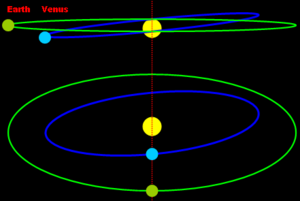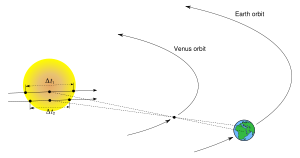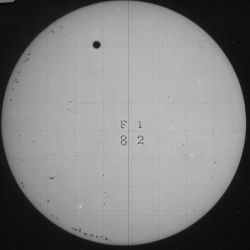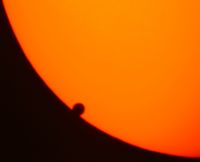Transit of Venus
2008/9 Schools Wikipedia Selection. Related subjects: Space (Astronomy)
A transit of Venus across the Sun takes place when the planet Venus passes directly between the Sun and Earth, obscuring a small portion of the Sun's disk. During a transit, Venus can be seen from Earth as a small black disk moving across the face of the Sun. The duration of such transits is usually measured in hours (the transit of 2004 lasted six hours). A transit is similar to a solar eclipse by the Moon, but, although the diameter of Venus is almost 4 times that of the Moon, Venus appears much smaller because it is much farther away from Earth. Before the space age, observations of transits of Venus helped scientists use the parallax method to calculate the distance between the Sun and the Earth.
Transits of Venus are among the rarest of predictable astronomical phenomena and currently occur in a pattern that repeats every 243 years, with pairs of transits eight years apart separated by long gaps of 121.5 years and 105.5 years. Before 2004, the last pair of transits were in December 1874 and December 1882. The first of a pair of transits of Venus in the beginning of the 21st century took place on June 8, 2004 (see Transit of Venus, 2004) and the next will be on June 6, 2012 (see Transit of Venus, 2012). After 2012, the next transits of Venus will be in December 2117 and December 2125.
A transit of Venus can be safely observed by taking the same precautions as when observing the partial phases of a solar eclipse. Staring at the brilliant disk of the Sun (the photosphere) with the unprotected eye can quickly cause serious and often permanent eye damage.
Conjunctions
Normally when the Earth and Venus are in conjunction they are not aligned with the Sun. Venus' orbit is inclined by 3.4° to the Earth's so it appears to pass under (or over) the Sun in the sky. Transits occur when the two planets happen to be in conjunction at (or very near) the line where their orbital planes cross. Although the inclination is only 3.4°, Venus can be as far as 9.6° from the Sun when viewed from the Earth at inferior conjunction. Since the angular diameter of the Sun is about half a degree, Venus may appear to pass above or below the Sun by more than 18 solar diameters during an ordinary conjunction.
Sequences of transits occur in a pattern that repeats every 243 years, with transits occurring eight years apart followed by a gap of 121.5 years, then a gap of eight years and then another long gap of 105.5 years. The pattern repeats every 243 years because 243 sidereal orbital periods of the Earth (365.25636 days - slightly longer than the tropical year) is 88757.3 days, and 395 sidereal orbital periods of Venus (224.701 days) is 88756.9 days. Thus, after this period both Venus and Earth have returned to very nearly the same point in each of their respective orbits. This period of time corresponds to 152 synodic periods of Venus.
The pattern of 105.5, 8, 121.5 and 8 years is not the only pattern that is possible within the 243-year cycle, due to the slight mismatch between the times when the Earth and Venus arrive at the point of conjunction. Prior to 1518, the pattern of transits was 8, 113.5 and 121.5 years, and the eight inter-transit gaps before the 546 transit were 121.5 years apart. The current pattern will continue until 2846, when it will be replaced by a pattern of 105.5, 129.5 and 8 years. Thus, the 243-year cycle is relatively stable, but the number of transits and their timing within the cycle will vary over time.
Ancient history
Ancient Greek, Egyptian, Babylonian, and Chinese observers knew of Venus and recorded the planet’s motions. The early Greeks thought that the evening and morning appearances of Venus represented two different objects, Hesperus - the evening star and Phosphorus - the morning star. Pythagoras is credited with realizing they were the same planet. In the 4th century BC, Heraclides Ponticus proposed that both Venus and Mercury orbited the Sun rather than Earth. There is no evidence that any of these cultures knew of the transits. Venus was important to ancient American civilizations, in particular for the Maya, who called it Noh Ek, "the Great Star" or Xux Ek, "the Wasp Star"; they embodied Venus in the form of the god Kukulkán (also known or related to Gukumatz and Quetzalcoatl in other parts of Mexico). In the Dresden Codex, the Maya chart Venus' full cycle, but despite their precise knowledge of its course, there is no mention of the transit.
Modern observations
Aside from its rarity, the original scientific interest in observing a transit of Venus was that it could be used to determine the size of the solar system by employing the parallax method. The technique is to make precise observations of the slight difference in the time of either the start or the end of the transit from widely separated points on the Earth's surface. The distance between the points on the Earth can then be used as a baseline to calculate the distance to Venus and the Sun via triangulation.
Although by the 17th century astronomers could calculate each planet's relative distance from the Sun in terms of the distance of the Earth from the Sun (an astronomical unit), an accurate absolute value of this distance had not been calculated.
Despite Johannes Kepler being the first to predict a transit of Venus in 1631, no one in Europe observed it because Kepler's predictions were not sufficiently accurate to predict that the transit would not be visible in most of Europe.
The first European scientific observation of a transit of Venus was made by Jeremiah Horrocks from his home in Much Hoole, near Preston in England, on 4 December 1639 ( November 24 under the Julian calendar then in use in England). His friend, William Crabtree, also observed this transit from Salford, near Manchester. Kepler had predicted transits in 1631 and 1761 and a near miss in 1639. Horrocks corrected Kepler's calculation for the orbit of Venus and realised that transits of Venus would occur in pairs 8 years apart, and so predicted the transit in 1639. Although he was uncertain of the exact time, he calculated that the transit was to begin at approximately 3:00 pm. Horrocks focused the image of the Sun through a simple telescope onto a piece of card, where the image could be safely observed. After observing for most of the day, he was lucky to see the transit as clouds obscuring the Sun cleared at about 3:15 pm, just half an hour before sunset. Horrocks' observations allowed him to make a well-informed guess as to the size of Venus, as well as to make an estimate of the distance between the Earth and the Sun. He estimated the distance of the Sun from the Earth at 59.4 million miles (95.6 Gm, 0.639 AU) - about half the correct size of 93 million miles (149.6 million km), but a more accurate figure than any suggested up to that time. However, Horrocks' observations were not published until 1661, well after his death.
Based on his observation of the transit of Venus of 1761 from the Petersburg Observatory, Mikhail Lomonosov predicted the existence of an atmosphere on Venus. Lomonosov detected the refraction of solar rays while observing the transit and inferred that only refraction through an atmosphere could explain the appearance of a light ring around the part of Venus that had not yet come into contact with the Sun's disk during the initial phase of transit.
The transit pair of 1761 and 1769 were used to try to determine the precise value of the astronomical unit (AU) using parallax. This method of determining the AU was first described by James Gregory in Optica Promota in 1663. Following the proposition put forward by Edmond Halley (who had died almost twenty years earlier), numerous expeditions were made to various parts of the world in order to observe these transits; an early example of international scientific collaboration. In an attempt to observe the first transit of the pair, scientists and explorers from Britain, Austria and France travelled to destinations around the world, including Siberia, Norway, Newfoundland and Madagascar. Most managed to observe at least part of the transit, but excellent readings were made in particular by Jeremiah Dixon and Charles Mason at the Cape of Good Hope. For the 1769 transit scientists travelled to Hudson Bay, Baja California (then under Spanish control) and Norway, as well as the first voyage of Captain Cook in order to observe the transit from Tahiti. The Czech astronomer Christian Mayer was invited by Catherine the Great to observe the transit in Saint Petersburg, but his observations were mostly obscured by clouds. The unfortunate Guillaume Le Gentil spent eight years travelling in an attempt to observe either of the transits; his unsuccessful journey led to him losing his wife and possessions and being declared dead (his efforts became the basis of the play Transit of Venus by Maureen Hunter).
Unfortunately, it was impossible to time the exact moment of the start and end of the transit due to the phenomenon known as the " black drop effect". The black drop effect was long thought to be due to Venus' thick atmosphere, and initially it was held to be the first real evidence that Venus had an atmosphere; however recent studies demonstrate that it is an optical effect caused by the smearing of the image of Venus by turbulence in the Earth's atmosphere or imperfections in the viewing apparatus.
In 1771, using the combined 1761 and 1769 transit data, the French astronomer Jérôme Lalande, calculated the astronomical unit to have a value of 153 million kilometers(±1 million km). The precision was less than hoped-for because of the black drop effect, but still a considerable improvement on Horrocks' calculations. Transit observations in 1874 and 1882 allowed this value to be refined further. Several expeditions were sent to the Kerguelen Archipelago for the 1874 observations. The American astronomer, Simon Newcomb, combined the data from the last four transits and derived a value of 149.59 million kilometers (±0.31 million km). Modern techniques, such as space probe telemetry and radar observations of solar system objects, have allowed a precise value for the astronomical unit to be calculated (to an accuracy of ±30 m), and so negated the need for parallax calculations.
There was however a good deal of interest in the 2004 transit as scientists attempted to measure the pattern of light dimming as Venus blocked out some of the Sun's light, in order to refine techniques that they hope to use in searching for extrasolar planets. Current methods of looking for planets orbiting other stars only work for a few cases: planets that are very large (Jupiter-like, not Earth-like), whose gravity is strong enough to wobble the star sufficiently for us to detect changes in proper motion or Doppler shift changes in radial velocity, Jupiter or Neptune sized planets very close to their parent star, or through gravitational microlensing by planets which pass in front of background stars with the planet-parent star separation comparable to the Einstein ring. Measuring light intensity during the course of a transit, as the planet blocks out some of the light, is potentially much more sensitive, and might be used to find smaller planets. However, extremely precise measurement is needed: for example, the transit of Venus causes the Sun's light to drop by a mere 0.001 magnitude, and the dimming produced by small extrasolar planets will be similarly tiny.
Past and future transits
Transits can currently occur only in June or December (see table). These dates are slowly getting later; before 1631, they were in May and November. Transits usually occur in pairs, on nearly the same date eight years apart. This is because the length of eight Earth years is almost the same as 13 years on Venus, so every eight years the planets are in roughly the same relative positions. This approximate conjunction usually results in a pair of transits, but it is not precise enough to produce a triplet, since Venus arrives 22 hours earlier each time. The last transit not to be part of a pair was in 1396. The next will be in 3089; in 2854 (the second of the 2846/2854 pair), although Venus will just miss the Sun as seen from the centre of the Earth, a partial transit will be visible from some parts of the southern hemisphere.
| Transits of Venus | |||||
|---|---|---|---|---|---|
| Date(s) of transit |
Time ( UTC) | Notes | Transit Path (HM Nautical Almanac Office) |
||
| Start | Mid | End | |||
| 1396 November 23 | 15:45 | 19:27 | 23:09 | Last transit not part of a pair. Some believe Aztec astronomers may have seen this transit. | |
| 1518 May 25-26 | 22:46 May 25 |
01:56 May 26 |
05:07 May 26 |
||
| 1526 May 23 | 16:12 | 19:35 | 21:48 | Last transit before invention of telescope | |
| 1631 December 7 | 03:51 | 05:19 | 06:47 | Predicted by Kepler | |
| 1639 December 4 | 14:57 | 18:25 | 21:54 | First transit observed by Horrocks and Crabtree | |
| 1761 June 6 | 02:02 | 05:19 | 08:37 | Lomonosov observes the atmosphere of Venus | |
| 1769 June 3-4 | 19:15 June 3 |
01:35 June 4 |
Captain Cook's voyage to Tahiti | ||
| 1874 December 9 | 01:49 | 04:07 | 06:26 | Pietro Tacchini leads expedition to Muddapur, India. | |
| 1882 December 6 | 13:57 | 17:06 | 20:15 | John Phillip Sousa composes a march, "The Transit of Venus", in honour of the transit. | |
| 2004 June 8 | 05:13 | 08:20 | 11:26 | Various media networks globally broadcast live video of the Venus transition. | |
| Transits of Venus | |||||
|---|---|---|---|---|---|
| Date(s) of transit |
Time ( UTC) | Notes | Transit Path (HM Nautical Almanac Office) |
||
| Start | Mid | End | |||
| 2012 June 5-6 | 22:09 June 5 |
01:29 June 6 |
04:49 June 6 |
Visible in its entirety from Hawaii, Alaska, Australia, the Pacific and eastern Asia, with the beginning of the transit visible from North America. | |
| 2117 December 10-11 | 23:58 December 10 |
02:48 December 11 |
05:38 December 11 |
Visible in entirety in eastern China, Japan, Taiwan, Indonesia, and Australia. Partly visible on extreme U.S. West Coast, and in India, most of Africa, and the Middle East. | |
| 2125 December 8 | 13:15 | 16:01 | 18:48 | Visible in entirety in South America and the eastern U.S. Partly visible in Western U.S., Europe, and Africa. | |
| 2247 June 11 | 08:42 | 11:33 | 14:25 | Visible in entirety in Africa, Europe, and the Middle East. Partly visible in East Asia and Indonesia, and in North and South America. | |
| 2255 June 9 | 01:08 | 04:38 | 08:08 | Visible in entirety in Russia, India, China, and western Australia. Partly visible in Africa, Europe, and the western U.S. | |
| 2360 December 12-13 | 22:32 December 12 |
01:44 December 13 |
04:56 December 13 |
Visible in entirety in Australia and most of Indonesia. Partly visible in Asia, Africa, and the western half of the Americas. | |
| 2368 December 10 | 12:29 | 14:45 | 17:01 | Visible in entirety in South America, western Africa, and the U.S. East Coast. Partly visible in Europe, the western U.S., and the Middle East. | |
| 2490 June 12 | 11:39 | 14:17 | 16:55 | Visible in entirety through most of the Americas, western Africa, and Europe. Partly visible in eastern Africa, the Middle East, and Asia. | |
| 2498 June 10 | 03:48 | 07:25 | 11:02 | Visible in entirety through most of Europe, Asia, the Middle East, and eastern Africa. Partly visible in eastern Americas, Indonesia, and Australia. | |
Grazing and simultaneous transits
Sometimes Venus only grazes the Sun during a transit. In this case it is possible that in some areas of the Earth a full transit can be seen while in other regions there is only a partial transit (no second or third contact). The last transit of this type was on 6 December 1631, and the next such transit will occur on 13 December 2611. It is also possible that a transit of Venus can be seen in some parts of the world as a partial transit, while in others Venus misses the Sun. Such a transit last occurred on November 19, 541 BC, and the next transit of this type will occur on 14 December 2854.
The simultaneous occurrence of a transit of Mercury and a transit of Venus is possible, but only in the distant future. Such an event will next occur on 26 July, 69163, and again in 224508. The simultaneous occurrence of a solar eclipse and a transit of Venus is currently possible, but very rare. The next solar eclipse occurring during a transit of Venus will be on 5 April, 15232. The day after the transit of Venus on June 3, 1769 there was a total solar eclipse, which was visible in Northern America, Europe and Northern Asia.
Observing
The safest way to observe a transit is to project the image of the Sun through a telescope, binoculars, or pinhole onto a screen, but the event can be viewed with the naked eye using filters specifically designed for this purpose, such as an astronomical solar filter with a vacuum-deposited layer of chromium, eclipse viewing glasses, or Grade 14 welder's glass. An earlier method of using exposed black-and-white film as a filter is no longer regarded as safe, as small imperfections or gaps in the film may permit damaging UV rays to pass through. Also, processed colour film (unlike black-and-white film) does not contain silver, and is transparent to infra-red. This may result in burns to the retina. Observing the Sun directly without filters can cause a temporary or permanent loss of visual function, as it can damage or destroy retinal cells.
There are four named "contacts" during the transit - moments when the circumference of Venus touches the circumference of the Sun at a single point:
- First contact (external ingress): Venus is entirely outside the disk of the Sun, moving inward
- Second contact (internal ingress): Venus is entirely inside the disk of the Sun, moving further inward
- Third contact (internal egress): Venus is entirely inside the disk of the Sun, moving outward
- Fourth contact (external egress): Venus is entirely outside the disk of the Sun, moving outward.
A fifth named point is that of greatest transit, when Venus is at the middle of its path across the disk of the Sun and which marks the halfway point in the timing of the transit.







